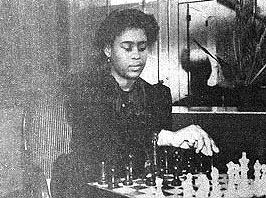By Matthew Grinberg, Founder of Alamogordo Chess Club
As noted in a recent post, Diana Lanni has been suggested (by herself, among others) as a possible inspiration for Walter Tevis in writing The Queen’s Gambit.

Another teenage girl Baraka Shabazz, who was playing a strong game of chess around the same time, may have also been an inspiration for Tevis.
 Here is a story about her from the Washington Post the title of which suggests this influence.
Here is a story about her from the Washington Post the title of which suggests this influence.
In 1981 at the age of 15 and the sixth rated female player in the US, she was invited to play in the first World Under-16 Girls’ Chess Tournament. As noted in the Washington Post article, “In a field of 32 contestants from 18 countries, she won three games and drew four, sharing third-place honors with two others.”
At the time she was living in the Washington, DC area, and had gained considerable attention in the local chess community. I lived in the area at the same time and in October, 1981 I was paired against her in a DC Chess League match. Given her reputation, I was apprehensive about playing her. Early in the middle game I was in a constrained position and gave up a pawn to get my pieces active. When it became apparent that I was going to win the pawn back with an even position, she offered a draw and I thankfully accepted.
In 1983 after a bad performance in the World Open, she unfortunately quit chess and never came back.
Here is an entertaining game she played in 1980. Her opponent tries to blitz her off the board from the start, but ends up paying the price. Her queen sacrifice at the end is great:
Arne, Mike – Shabazz, Baraka, 0-1
Berkeley Open
Berkeley, California, 1980
Petroff’s Defense: Urusov Gambit
- e4 e5 2. Nf3 Nf6 3. d4 This is a dynamic answer to Petroff’s Defense.
[The standard line is 3. Nxe5 d6 4. Nf3 Nxe4 5. d4 d5 White has his normal opening advantage]
3… exd4!?
[More common is 3… Nxe4 4. Bd3 d5 5. Nxe5 Nd7 6. Nxd7 Bxd7 7. O-O Again White has his normal opening advantage]
- Bc4!? The Urusov Gambit – Until I looked at this game I had never heard of it.
[Better and leading to an advantage in development for White is 4. e5 Ne4 5. Qxd4 d5 6. exd6 Nxd6 7. Nc3]
4… Nxe4!? Shabazz accepts the gambit.
[4… Nc6 transposes to a common line of the Two Knights Defense. 5. e5 d5 6. Bb5 Ne4 7. Nxd4 Bd7=]
- Qxd4 Nf6 6. Bg5 Be7 7. Nc3 Nc6
[In the following game, Black makes a serious error on his last move. 7… c6 8. O-O-O d5 9. Rhe1 Be6 10. Qh4 Nbd7 11. Nd4 O-O 12. Rxe6 fxe6 13. Nxe6 Qe8 14. Nxf8 Qxf8 15. Bd3 Re8 16. Qh3 Qf7 17. Ne2 Nf8 18. Bd2 Bc5 19. Ng3 Ne4 20. Nf5 Nxf2 21. Qg3 Nxd3 22. Qxd3 Ng6 23. Rf1 Qc7 24. Bc3 Bf8 25. h4 Ne5 26. Qg3 Qb8?? (26… h5 keeps him in the game.) 27. Bxe5 1-0, Nikitin, Andrey (RUS) 2458 – Afonin, Sergey (RUS) 2195, St. Petersburg 2003 Tournament (open) “Petersburg’s Autumn” If the game had continued, then he would have had to give up his queen to avoid checkmate. 27… Qxe5 28. Nh6 Kh8 29. Qxe5 Black cannot recapture]
- Qh4 d6 9. O-O-O Be6 10. Bxe6 fxe6 11. Rhe1 Qd7N
[This simultaneous game is the last game in my database that follows this line. White’s nice trick at the end securs the draw. 11… Qc8 12. Ne4 e5 13. Nxf6 Bxf6 14. Bxf6 gxf6 15. Qxf6 Rf8 16. Qg7 Qd7 17. Qxd7 Kxd7 18. Nxe5 Nxe5 19. Rxe5 Rxf2 20. Rg5 Re8 21. Rg7 Kc6 22. Kb1 Ree2 23. Rc1 Rxg2 24. Rxh7 Rxh2 25. Rxh2 Rxh2 26. a4 Kc5 27. b3 c6 28. Kb2 d5 29. Rg1 d4 30. Rg3 a6 31. Rf3 b5 32. axb5 axb5 33. Kc1 Kb4 34. Rf4 c5 35. Kb2 Rd2 36. Rh4 Ka5 37. Kc1 Rg2 38. Rf4 Kb4 39. Kb2 Rd2 40. Rh4 c4 41. bxc4 bxc4 42. Rxd4! Rxd4 43. c3 1/2-1/2, Hausner, Ivan (CZE) 2434 – Satransky, Jaroslav (CZE) 2225, Rakovnik 2001 Simultaneous]
- Qc4 O-O-O 13. Rxe6 White wins back the pawn and still has more active pieces, but Black’s d-pawn against no center pawns for White gives her compensation 13… h6 14. Bf4 d5 15. Qe2 Bc5
- Rxf6?! He gives up an exchange for a pawn to break up Black’s position and launch an attack – it’s daring, but not sound. The game begins to go wacko and both players have a hard time finding their way in the complications.
[After 16. Bg3 Rhf8 17. Kb1 the game is equal]
16… gxf6 17. Nxd5 With threats on c7, f6 and b6 it looks like White’s sacrifice was good. 17… Bd6? This is the obvious way to stop the threats on c7 and b6, only giving up the pawn on f6. But…
[Both players overlooked 17… Nd4! Now Black threatens to take the queen with check or take the undefended knight on d5. 18. Nxd4 Qxd5 Black still has an exchange for a pawn]
- Bxd6 cxd6
[Also playable is 18… Qxd6 19. Nb6 axb6 20. Rxd6 Rxd6 Black has two rooks for a queen and pawn, but the pawn structure gives White a small edge]
- Qc4 Kb8 20. Nxf6?! Winning the pawn with an attack on the queen is obvious, but it is premature.
[Black cannot correct the weakness in her pawn structure. It is best for White to increase the pressure on Black and secure his own pawn structure before trying to cash in. 20. Nh4! Qe6 (Or 20… Qg7 21. Ne3 Ne7 22. Qe6 d5 23. Nhf5 Nxf5 24. Qxf5 Qg5 25. Rxd5=) 21. Qf4 h5 22. g3 Ne5 23. Nf5 Rhg8 24. Qe4 Rde8 25. f4 Nc6 26. Qxe6 Rxe6= The knights have a strangle hold on Black’s position and give him compensation for being down an exchange for a pawn]
20… Qg7 21. Ng4 Rhe8?!
[21… d5 gains some space since 22. Rxd5? (Better is 22. Qf4 Ka8 But Black is still better because, in the open position Black’s rooks are more active than White’s knights) 22… Rxd5 23. Qxd5 Qxg4 leaves Black up a rook for three pawns]
- Ne3 White’s position is now solid and Black can no longer play d5. 22… Qg6 23. Nd4 Ne5 24. Qb4 d5 She advances the d-pawn anyway. It works here, but it comes with some risk. 25. Ndf5!? He suckers Black into a bad move.
[But the solid 25. g3 may be better]
25… Rd7?! Shabazz overlooks the trick Arne has up his sleeve.
[25… Nc4! would hold the d-pawn with an equal position. 26. c3 (Not 26. Rxd5?? Rxd5 27. Nxd5 Qxg2! 28. Qxc4 Qg1 29. Kd2 Qxf2 30. Kc3 (30. Kd3 Qe2 31. Kc3 Rc8 Black wins) 30… Rc8 Black wins) 26… h5 27. g3 Qf7 28. Nxc4 dxc4 29. Nd4=]
- Rxd5! Rc7? Black now sees the problem with playing to win the knight on f5, but balks too soon.
[Even though it does not win the knight 26… Rxd5 it is still best. 27. Nxd5 Qc6 (27… Qxf5?? 28. Qd6 Ka8 29. Nc7 Kb8 30. Na6 Ka8 31. Qb8 Rxb8 32. Nc7#) 28. Qd4 Qc4 29. Qxc4 Nxc4 30. Nfe3 Nxe3 31. Nxe3 With three pawns for the exchange, White is better, but Black has chances]
- Qf4 Down three pawns for an exchange and with three of her pieces in the line of the White queen on the h2-b1 diagonal, Black is in serious trouble. 27… Qf6 28. Kb1? White thinks that he is getting his king out of harm’s way, but in fact he is setting himself up for disaster because of the potential for Black’s rook on e8 to get to e1. Shabazz pounces on the idea immediately! I have a suspicion that White was short of time since he misses a lot in the last 9 moves.
[28. Qxh6 Qxh6 29. Nxh6 Rh7 30. Nef5 With four pawns for an exchange, White should win]
28… Nc4! 29. Qd4!? Okay, but…
[The better way to stop the mate threat on b2 is 29. c3 which also stops back rank mate threats. 29… Qc6 30. a3 Rf8 31. Qxc4 Qxc4 32. Nxc4 Rxc4 White has a small edge;
- Nxc4?? Re1 30. Qc1 Rxc1 31. Kxc1 Rxc4 Black wins]
29… Nxe3! Now it is Black that suckers White into a bad move. 30. Qxf6? You would think a player would be wary when their opponent leaves her queen hanging. But perhaps, as I suggested earlier, he was in time trouble.
[30. fxe3 Qxd4 31. Rxd4 Rf7 32. g4 h5 33. h3 hxg4 34. hxg4 Rh7 35. b3 White has three pawns for the exchange, but his isolated e and g-pawns give Black equality]
30… Nxd5! Capturing the rook, attacking the undefended queen and threatening mate in one. White is forced to give up his queen for a rook, leaving him a rook down. 31. Qxh6 Re1 32. Qc1 Rxc1 33. Kxc1 Nf4 34. g4? This saves the g-pawn from immediate capture, but weakens his pawn structure. If White had a chance to save the game, it is gone with this move.
[34. g3 also loses the f-pawn, but it keeps his remaining kingside pawns safe. 34… Nd3 35. Kd2 Nxf2 With three pawns for the rook, including two connected passed pawns, White has chance, but Black should still win]
34… Nd3 35. Kd2 Nxf2 Now because of the weakness created by his 34th move, he loses another pawn. 36. g5
[No better is 36. Ne3 Rg7 37. h3 Nxh3 leaving Black up a rook for two pawns anyway]
36… Ne4 White resigns. [0:1]
I think Mike Arne learned that he should not play for tactics against Baraka Shabazz.


Hi, it’s good to see one of my games on paper.
By the way, the article you quoted from missed out a very important part of the Showcase, that I set up is that I was blindfolded. I played 20 games blindfolded.
Take a break from the ordinary and dive into the extraordinary with our online casino games – where every spin is a chance to win big.
Get the ultimate casino experience from the comfort of your home!
What fabulous ideas you have concerning this subject! By the way, check out my website at <a href="[Link deleted]for content about Cosmetic Treatment.
One of the most fun sandbox games out there, Melon Playground lets you experiment with tools, physics, and characters like never before.
Explore famous cities, wild landscapes, and hidden corners of the planet in World Guesser, the ultimate global quiz.
Their knowledgeable professionals offer clear, actionable insights that drive impressive and lasting results.구글찌라시 Delivering excellence through skilled execution and thorough attention, this solution earns high praise from satisfied users.
Clients’ and their desired erotic service action will get carried out perfectly. After all, Geetika is a hot action babe who is excellent. With my client, there will be no doubts or feelings of something getting lost.
thank, i like it!
Their professional approach and commitment to quality make them a standout partner for any demanding project.강남쩜오 Expertise and reliability define this team, making them the top choice for anyone seeking quality and trustworthiness.
Step into <a href="[Link deleted]blast where your mission is simply to clear lines but the challenge quickly becomes an addictive test of skill.
Discover how satisfying it feels to earn high achievements in the block game as each cleared block row pushes your score higher.
Interesting. Good chess players are good at remembering and guessing moves.